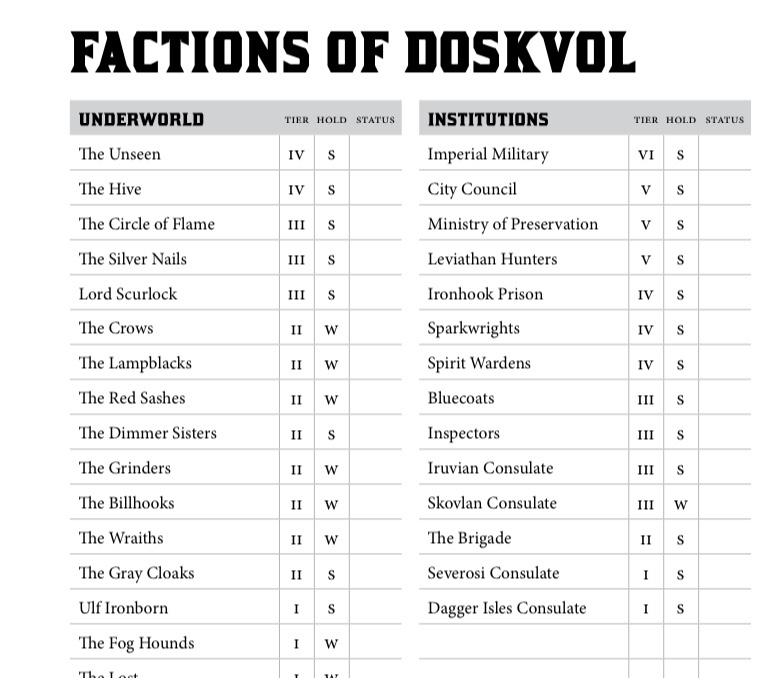I was writing up another technique I use to make cities feel lived in, and I realized that it rested on another technique that I should probably explain first, so that’s what this is. While this advice is technically for a city game, it’s applicable to any game where you might want to give the setting a rich, lived in feel.
Ok, so the first step in this technique is to keep a list of assets that you can easily reference. “Assets”, in this case, are elements of the setting that the characters have interacted with, most often in the form of NPCs, Places and Factions. The lines between these things can be blurry – a person might be tied to a place (like the bartender at a tavern) or a person might represent a faction – and that’s fantastic. Err on the side of making your list long. If The Church is a faction the group has dealt with, and Sister Annalise is a member of the church but also an NPC they’ve dealt with, list them separately.
I will note that in practice, I often find that a list like this ends up naturally dividing into “potential” and “activated” assets. Potential assets are ones which exist in the setting, but have not yet actually come up in play in any meaningful way. The table may know ABOUT them, but they have not really come up. Activated assets, on the other hand, are those which have actually been a part of play.
It’s reasonable to keep a list which includes both, since the list of potential assets can often be a useful source of inspiration. However, make sure to leave yourself space – as much as it’s easy to think that there will be a tidy movement of elements from potential to activated, I have yet to have a game where I do not end up with some surprises on the activated list.
Blades in the Dark offers very easy tools for creating this list. Every character starts with at least three potential assets (Positive & Negative contact plus vice dealer) and the Crew itself introduces one more. Past that, the faction sheet is one giant pile of potential assets.

That said, Blades also introduces one piece of caution – be conservative about considering assets to be active until they’re really been part of play. It is easy to look at character’s connections and consider them active from the start, but they’re really not until the whole table has gotten to see them in action. If you treat an asset as active before there has been actual play, you risk misunderstanding what players are actually interested in. This becomes an even more pronounced risk when you start thinking about an asset as active because you’re excited about it, but it hasn’t actually hit the table.
Ok, so you have your list: now what?
Well, this is the easy part – as a GM, you will frequently find yourself faced with questions that are best answered with an asset. That is, questions like “Who is interested in this?”, “Where is this happening?”, “Who else is there” and so on. You’ll recognize these as they come up because they are the questions you ask when it feels like things are happening in too much of a vacuum, and the world needs to be part of the discussion.
When your game starts and you come to one of those questions, you should activate an asset (or just invent a new one and add it). Having the list on hand will hopefully make this process pretty simple, and with practice it gets simpler. And, honestly, this is probably what you’d do anyway, just with a little more formality.
The real trick kicks in when you hit a tipping point in the number of activated assets. There’s no hard number for this, but it’s probably around three per player (including the GM). It’s easy to spot this tipping point because at some point you will have an asset question, and the best answer will be an active asset rather than a potential one. This is a good moment – at that moment, things in the game start tying together in a way that feels satisfying and organic. It rocks.
That is, however, not the real point of magic.
Real magic happens once you’ve passed the tipping point and you get another asset question, and it doesn’t seem like any of the active assets are a good answer. At that point, you must do the following:
Pick an active asset anyway, and run with it.
This may seem weird or unintuitive, but that is the point. This is a forcing function for you as a GM, because doing this will force you to create new connections that had not previously existed in your vision of the setting. This will shake up your expectations and make things feel more organic and dynamic, but it will also make things more fun for you as a GM as you try to figure out how to Apollo 13 this stuff.
Once you’ve done this, it may be a while before you need to do it again. Keep using active assets when you can. Activate passive assets if you need to keep things fresh. But remember this technique and bust it out from time to time in order to keep you and your table on their toes. The results will be rewarding and memorable.
Pingback: Communication as Technique | The Walking Mind
This feels very in tune with how TechNoir is meant to be run. I’d love to see this method turned into a 2d relationship map